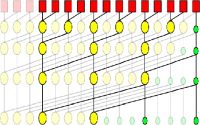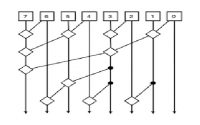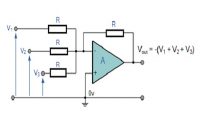2N4403 Transistor : Pin Configuration & Its Applications
2n4403 transistor is a PNP-based bipolar junction transistor and it includes three layers like P, N & P where the ‘N’ doped layer is arranged in between the two P-doped layers. This transistor is available in the TO-92 plastic package. In this transistor, the conduction can be carried out throughout the movement of charge carriers.
In 2N4403 Transistor, the majority charge carriers are holes whereas minority charge carriers are electrons. This article discusses an overview of the 2N4403 transistor and its working with applications.
What is a 2N4403 Transistor?
2N4403 Transistor is a general-purpose PNP transistor that is used in amplifier and low power switching applications. This transistor includes three terminals like Emitter, Base & Collector whereas three layers like P, N & P. Here two ‘P’ layers represent two terminals like emitter & collector whereas the ‘N’ layer represents the base terminal of the transistor respectively.
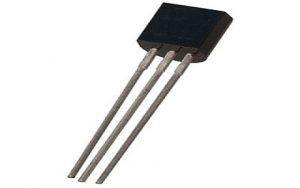
The working of this PNP transistor is similar to NPN where the flow of current at the base terminal is mainly utilized to manage the huge current at the remaining two terminals because it is a PNP type transistor thus base terminal of the transistor will be negative as compared to emitter terminal.
Generally, most of the transistors available in the market work as a switch because once we provide a small amount of voltage at the base terminal then it will control the huge current at the remaining two terminals. So, here the switch will be considered like ON. Once there is no current at the base terminal then the switch will be considered like OFF.
PNP-based transistors are also called current-controlled devices as tiny current at the base terminal is utilized mainly to manage the huge amount of current at the remaining two terminals in the transistor.
Pin Configuration of 2N4403 Transistor
The pin configuration of the 2N4403 transistor is shown below. This transistor includes three terminals where each terminal with its functionality is discussed below.
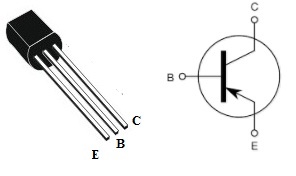
- Pin1 (Emitter): This pin is generally allied to power
- Pin2 (Base): This pin is used to activate or deactivate the transistor
- Pin3 (Collector): This pin is normally allied to load.
Generally, the PNP transistor is considered like OFF, however, at the base terminal, the negative voltage & small amount of output current will be activated this transistor so that a large amount of current will supply from the emitter to collector terminals.
This kind of transistor conducts once the voltage at the collector terminal is smaller as compared to the voltage at the emitter terminal. Here the sum of both the terminals like base & collector is equal to the flow of current at the emitter terminal.
Features & Specifications
The features & specifications 2N4403 transistor include the following.
- This is an epitaxial transistor with silicon planar
- The type of transistor is PNP
- The available package is TO-92
- Dissipation of power is 0.31 W
- The packages accessible are Pb−free
- Temperature ranges from -55ºC to +150ºC
- DC gain (hFE) is 300
- The voltage across the base & emitter is (Max) is 5V
- The flow of current throughout the base terminal (Max) is 50mA
- Voltage across C & E (Max) is 40V
- Voltage across C & B (Max) is 40 V
- The flow of current throughout collector terminal (Max) is 600mA
- Similar and replacement 2N4403 transistors are 2N5401, NTE159, 2N3905, 2SA1015GR, SS9012, 2N2907, 2N3906, BC528, MPS2907, ZTX550, PN2905, BC880 & BC878.
- How to use 2N4403 Transistor for a Long Time Securely?
- The following precautions must be taken while using this transistor.
- If you want to use this transistor for a long time securely then you should not exceed the defined values in the above features.
- Always use below maximum values for long term performance & safety
- Should not drive loads above 600mA by using this transistor & operate the load under 40V DC.
- An appropriate resistor must be used with this transistor and pinout must be checked before connecting in the circuit.
- The operating temperature range must be under -55 C & above +150 C.
Latch Switch Circuit with Transistors
The latch switch circuit using transistors is shown below. This type of circuit mainly works like a nonstop open switch when it gets an input signal & stays open even the input pulse is gone.
This circuit mainly uses different methods, so this circuit uses transistors to execute the function of the latch. This circuit uses basic electronic components like two transistors (2N4403 & 2N4401) & some resistors.
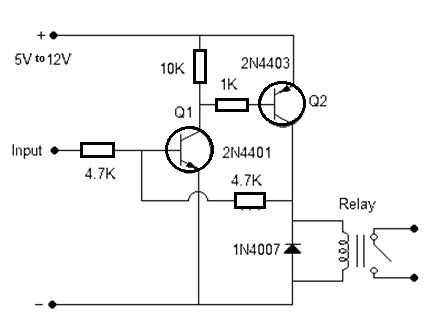
At the output, this circuit uses a relay switch to control the electronic application otherwise a device. This circuit can be understood by understanding the two transistors like Q1 & Q2 first. Once an input signal is given at the base terminal of the Q1 transistor, then it will conduct & unites the base terminal of the Q2 transistor toward the GND.
Consequently, the Q2 transistor also starts conducting to trigger the relay which is allied with the Q2 transistor’s collector terminal. Here, a 4.7K resistor is used by connecting from the collector terminal of the Q2 transistor to the base terminal of the Q1 transistor. So that it provides a feedback voltage on the base terminal of the Q1 transistor and it makes the Q1 transistor conduct constantly until the power supply is detached.
Where to use/Applications
The applications of the 2N4403 transistor include the following.
- The 2N4403 transistor is used to control relay switches, control different kinds of LEDs, MOSFET controlling, in electronic circuits, to control ICs.
- Additionally, this transistor is used as a small amplifier at the circuit o/p to drive a speaker directly.
- It is used as an amplifier within several audio circuits.
- It is used as a microphone preamplifier
- It is used as a preamplifier for several small audio signals.
- It amplifies any kind of small signal.
- Generally, this transistor is used in switching devices of low power loads.
- It is suitable for random switching devices
- It is used as a power amplifier to amplify low-power signals.
- Used for amplification of voltage & power
- Once both the PNP & NPN transistors are used then the current supplies alternatively from both sides of transistors.
- Used in switching applications
- Lighting systems
- Signal Amplifiers
- Relay drivers
- Audio Amplifiers
- Sensor circuits
Thus, this is all about an overview of the 2N4403 transistor datasheet which includes its pin configuration, features, specifications, circuit working with applications. Here is a question for you, what are the different types of PNP transistors available in the market?


